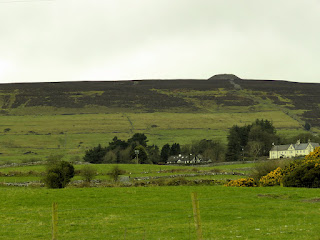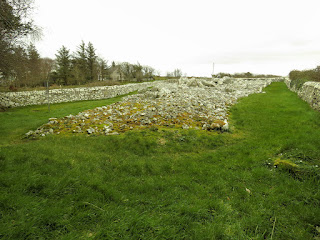Donegal is mountainous, rural, less touristy and our host in Dublin seemed somewhat surprised that we were staying in Donegal for a week. She referred to Donegal as ‘wild and woolly’ just our type of place. We are near a main road so it makes it easy for us to travel and the road is in great condition. The Republic of Ireland has excellent signage, which include distance signs to towns, and of course, many roundabouts.
Knocknarea
Sligo is in a gorgeous area loaded with Neolithic monuments. There is a huge tomb on the top of the mountain called Knocknarea, which is very close to Sligo. The tomb can be seen for miles as it sits quite high on a flat-topped hill. We met an older man walking down who told us that it is the tomb of Queen Maeve, and I had read the legend of Queen Maeve of Connaught, when I researched this trip.
Legend tells us that Queen Maeve and her husband, Ailill, were having a discussion regarding which one of them had the most wealth. Ailill claimed that he had the edge because he owned the bull Finnbhennach. In order to equal the wealth of Ailill, Maeve had to get her hands on another great bull known as Donn Cuailnge which lives in Ulster. She negotiated with his owner to lease the bull for a period of one year. Her messengers got drunk and let is slip that Maeve would have taken the bull by force if the owner had not agreed to rent her the bull, thus, causing the deal to break down.
To get her bull, Maeve raises an army and a great battle takes place. Maeve captures the bull Donn Cuailnge, and takes it home to Connaught where it kills Ailill’s bull and then heads home to Ulster. As a result, Maeve and Ailill now have equal wealth as his bull has been killed. There are several versions of this legend, John thinks it is a lot of bull.
We walked up Knocknarea, it is not very far and is only an elevation gain of about 600 feet. Once we got to the top we could see a big squall coming at us and the wind picked up, so we wandered around and took some photos before the rain hit. The views from Knocknarea would be superb on a clear day. Legends aside, the large Neolithic tomb dates from about 3400 BC, there are also six smaller cairns close to the summit.
When we were coming down Knocknarea, we met a couple of locals who were walking up to give their horses some pellets. We had a great chat with them about Ireland, Canada and Donald Trump; all the Irish ask us what we think of Trump, although they know we are Canadians. It started to rain, but the woman said it was too bad we couldn’t sit down to a coffee so we could continue to discuss things. All of the locals are so friendly, even when in a shop the staff will give us ideas of what to visit in Donegal.
Tomb on top of Knocknarea
This tomb is huge
View of Benbulbin from Knocknarea
Creevykeel
This is a court tomb, the oldest section dates from 2500 BC. The tomb was originally 180 feet long and 82 feet wide at the entrance to the oval court, which is 49 feet wide. The oval court leads to a two-chambered gallery and behind the gallery are three single-chambered tombs.
Entrance to Creevykeel Court Tomb
We were surprised by the length of this tomb
The lintel stone should be upright and not horizontal
Court tomb
We had planned to visit Carrowkeel, which is 25 km south of Sligo, but time was getting short, so we headed north toward our cottage. We did stop in at Bundoran for cappuccino, which was wonderful.
We will continue with another installment of the History of Ireland.
War was taking place in Scotland and England, Cromwell defeated the Scots and King Charles was captured by the English Parliament and executed. Cromwell then came to Ireland in 1649 with an army of 20,000 and slaughtered the Irish Catholics. By the time Cromwell left in 1650, Ireland was destroyed, famine and disease had reduced the population in the 1640s by 20 to 40%. Land ownership by Catholics declined by 40% from 1640 to 1660, now owning only 10% of the land. Protestants completely dominated politically and owned greater than 80% of the land, this level of domination would continue for the next 200 years.
The landscape of Ireland was completely transformed from forest to grazing land for cattle, at the expense of tillage. The previously open land was closed off with hedgerows and stone walls. By the end of the 1600s, the potato was under cultivation and a complete change in the diet of the poor classes was underway.
Landholding consisted of only a few thousand large estates owned by people born in Ireland, but of English origin who were mainly Protestant. The land was worked by leaseholding tenant farmers who were Catholic; however, in the northeast they were Presbyterian, descended from Scottish settlers.
As a result of the turbulence of the 1600s, there was essentially no industry in Ireland. The English had curtailed the export of live cattle to England in the 1670s, as the Irish economy was not to compete with the English economy. The Irish responded by exporting food products to Europe and North America. The Catholics were kept poor via the Penal Laws which denied them land ownership and ambition, as the majority of administrative positions were held by Protestants.
In the 1700s the Irish Parliament was made up of the landholding class, which was Protestant, both the Catholics and Presbyterians were excluded; the Presbyterians tended to be tenants or traders. The Irish Parliament had limited power as it was subordinate to, and controlled by, the British Parliament.
The Irish Protestants were also getting fed up with the English, as all of the highest administrative positions went to the English and there was a resentment building among Irish Protestants regarding the English view of Ireland as a colony, whose purpose was to benefit England. The Protestants started to feel a sense of Irish Patriotism and they felt secure in that the Catholics would never gain ground even though the Protestants were a minority. They began to build large country houses and to improve their large estates.
The English ignored the English origins of the Irish and began to view them as native Irish, assigning to them all of the traits that the Old English despised, that of: excessive drinkers, violent, outlandishly hospitable, having the ‘gift of the gab,’ good horsemen and desirous of patronage.







No comments:
Post a Comment